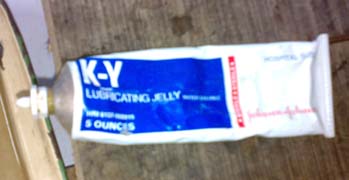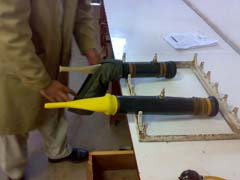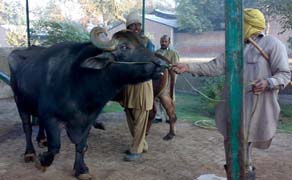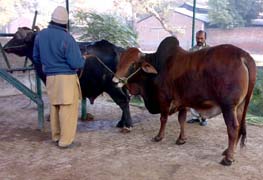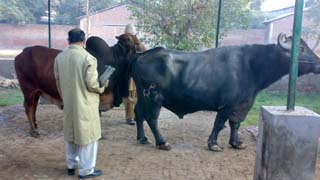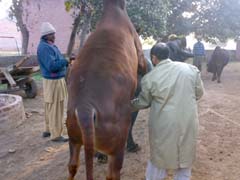 |
Pak Dairy Info
|
Home || Our Team || Dedication || Acknowledgement || Downloads || Articles || Site Map || References || Contact Us || Feedback
![]()
|
||||||
| Record Keeping | ||||||
|
||||||
|
|||||||||||||||||||||||||||||||||||||||
|
Collection of Semen Recovery method It is the oldest method. In this method bull is allowed to jump on cow and semen is collected from vagina by spoon, aspiration or sponge. Drawbacks:
Advantage:
Massage Method Gently insert lubricated hand and forearm into bull rectum. Remove feaces and gently massage the seminal vesicle with fingers by backward and downward strokes toward urethra. An assistant with receptacle will collect seminal fluid and semen as drips from penis. Ampule is massaged similarly in a slow rhythmic way. Sometimes semen is retained in sigmoid flexture of penis or in the proximal portion of the prepuce. Therefore after massage the ampule, sigmoid curvature should be straightened up.
Precaution:
Apparatus:
Principle:
Procedure:
It has been proved to be the best method and is now most commonly used. For cattle and buffalo artificial vagina consists of:
Before using for semen collection all the parts are washed thoroughly and sterilized properly, and assembled as artificial vagina. The rubber liner is inserted into the hose; inverting both ends back by folding back from either side
opening, and fastening with rubber bands. Now the space between the hard rubber hose and inner rubber liner is filled with hot water to provide. The graduated semen collection tube is fixed to the narrow end of the artificial vagina hose, and fastened by a rubber band. The inner side of the rubber liner on the anterior side of the artificial vagina is lubricated with sterile jelly to a length of 3 to 4 inches. Air is blown through the nozzle into the water jacket, to create pressure.
The temperature of the artificial vagina is more important and should always be checked before making the collection. Too high temperature may cause injury to the penis and the bull may refuse to serve in future, whereas at lower temperature, there may not be complete ejaculation. Prior to collection, bulls are usually allowed to become excited by bringing to cow or dummy. It will smell and also will make attempts to ride. During collection, the artificial vagina is held at an angle of 45o with the horizontal plane of the cow or dummy. It is so because the penis of the bull enters the vagina of the cow at that angle. When the bull mounts the penis is quickly guided into the artificial vagina with the operator’s hand. Care is taken not to touch the exposed part of the penis, as this stimulates the bull to ejaculate. After the bull dismounts, the artificial vagina is taken off the penis and is kept in an upright condition after releasing the pressure by draining water and air out of it. This allows the ejaculate to flow from the cone to the vial, which is then detached from the cone and taken to the laboratory for examination.
Evaluation of Semen Just after collection the ejaculate should be placed in a water bath maintain at 35 oC. It is important that semen examination should be carried out rapidly so that dilution and cooling can be initiated as soon as possible after semen collection. Gross Semen Evaluation
Volume:
General Appearance:
Presence of Pseudomonas aerogenosa changes the normal color to yellow green color. Clumps, clots, large plaques in semen indicate presence of varying amount of blood. Light brown color due to presence of feces.
pH of Semen:
Microscopic Evaluation Mass activity
Apparatus:
Procedure:
Precaution:
Individual motility is observed in order to estimate the total percentage of motile sperms in the ejaculate.
Apparatus:
Procedure: All live sperms are motile sperms. Those which have abnormal movement will not be able to fertilize the ovum and hence are considered as dead sperm. The motility of sperm is categorized in following category:
Progressive rectilinear is normal others are dead. Semen samples are classified according to rate of motility as follows: 80-100 % very good 60-80 % good 40-60 % fair 20-40 % poor 0-20 % very poor
Concentration is variable from ejaculate to ejaculate of the same bull, from bull to bull and from species to species. It is mostly used for research purposes, determining the rate at which semen should be diluted and for determining the bull output.
Apparatus:
Procedure: Formula:
Where X = total cells counted in squares 80 = squares where sperms were counted 400 = total squares 100 = dilution factor 10 = depth of counting chamber In modern semen production units semen evaluation is carried out through computerized system.
After evaluation semen is diluted in an 'extender'. This provides an appropriate concentration of spermatozoa, allowing more inseminations from each sample. A dilution of around 50 times is usual. The extender also nourishes and protects the spermatozoa during storage and distribution. Typically, the extender contains:
Semen is packed into the plastic straws and stored in liquid nitrogen at -196° C. Each straw contains around 20 million spermatozoa. There is slow deterioration of the effectiveness of semen with time. For use, the straws are thawed in water bath at 37 ° C for a few seconds before insemination to reactivate the spermatozoa.
|
|||||||||||||||||||||||||||||||||||||||
|
Copyrights © Dr. M Jassar Aftab, All Rights Reserved |
|||||||||||||||||||||||||||||||||||||||




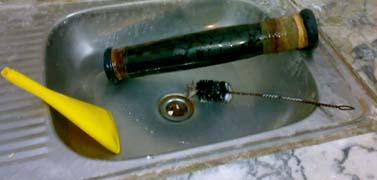
.jpg)


